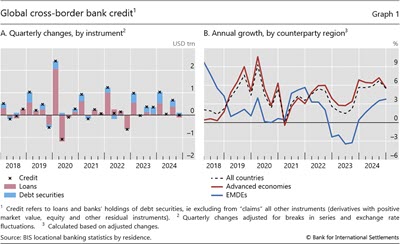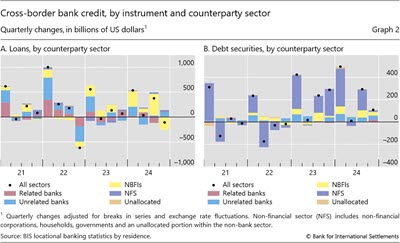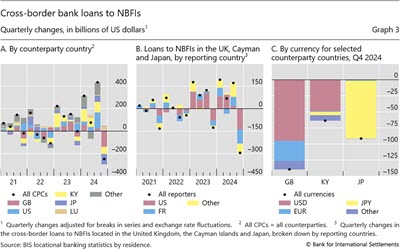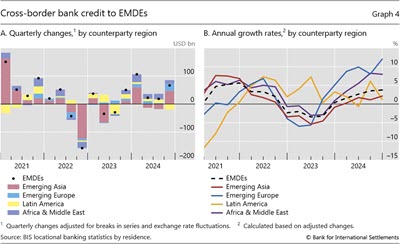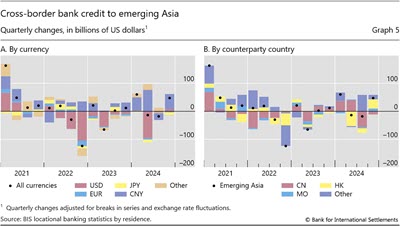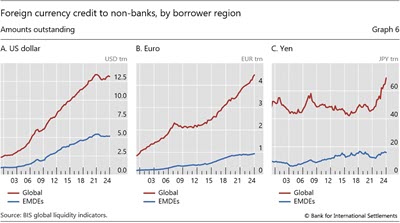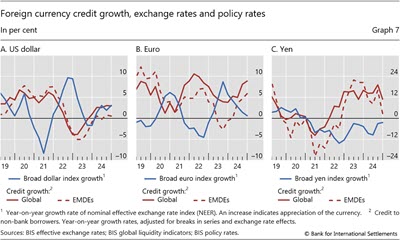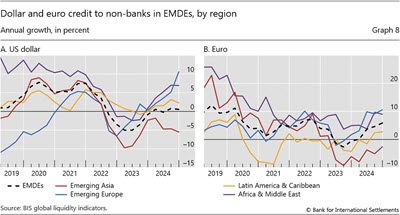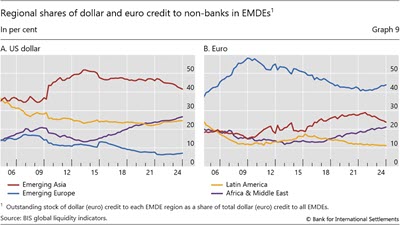Statistical release: BIS international banking statistics and global liquidity indicators at end-December 2024

Key takeaways
- Global cross-border bank credit remained virtually unchanged in the fourth quarter of 2024, ending the year with an outstanding stock of $32.6 trillion.
- Cross-border loans to non-bank financial institutions declined by $248 billion in Q4 2024. This brought down their annual growth rate to 12%.
- Cross-border bank credit to emerging market and developing economies (EMDEs) increased by $67 billion, or 3.8% year on year, mainly owing to a $47 billion expansion in cross-border bank lending to emerging Asia-Pacific.
- The BIS global liquidity indicators reveal that the share of Africa and the Middle East in dollar and euro credit to EMDEs has risen considerably over the past decade.
Cross-border bank loans to NBFIs contract
The BIS locational banking statistics (LBS) reveal that global cross-border bank credit1 inched down by $0.6 billion on an exchange rate- and break-adjusted basis in Q4 2024, (Graph 1.A).2 This brought its annual growth rate down to 5.5% (Graph 1.B). The outstanding stock of cross-border bank credit stood at $32.6 trillion as of end-2024.
Changes in cross-border bank loans and debt securities holdings offset each other in Q4 2024. Cross-border loans contracted by $109 billion, driven by a $248 billion reduction in loans to non-bank financial institutions (NBFIs) (Graph 2.A). Conversely, banks increased their cross-border holdings of debt securities by $109 billion, especially those issued by financial institutions (Graph 2.B).
The Q4 2024 contraction in banks' loans to NBFIs was the largest since Q2 2020. It was driven by declines in banks loans to NBFIs in the United Kingdom (-$140 billion), Japan ( -$92 billion) and the Cayman Islands ( -$64 billion) (Graph 3.A). The largest reductions in loans to NBFIs in these three jurisdictions were reported by banks located in the United States ( -$139 billion) and France ( -$95 billion) (Graph 3.B). The contractions in loans to NBFIs in the United Kingdom and the Cayman Islands were mainly dollar-denominated, whereas those to NBFIs in Japan were mostly yen-denominated (Graph 3.C).
Cross-border bank credit to EMDEs grew by $67 billion in Q4 2024 (Graph 4.A, black dots). This was the fifth consecutive quarterly expansion. It pushed the annual growth rate of the series up to 3.8% (Graph 4.B, dashed line).
The aggregate numbers conceal some variation across EMDE regions in Q4 2024. Cross-border bank credit to Latin America and the Caribbean declined by $19 billion, bringing down the annual growth rate to 1.2%. By contrast, cross-border lending to all other EMDE regions expanded. Cross-border bank credit to Africa and the Middle East (AME) rose by $14 billion (8% year on year). Emerging Europe saw an increase of $25 billion (12% year on year).
Among EMDE regions, emerging Asia saw the largest expansion in cross-border bank credit during Q4 2024 ($47 billion). This increased the annual growth rate of the series to 2.1%, the highest since Q1 2022. The Q4 2024 expansion was largely due to renminbi-denominated credit ($53 billion) (Graph 5.A). Among individual borrowing jurisdictions, cross-border bank credit (in all currencies) to Hong Kong SAR ($32 billion) and Macao SAR ($10 billion) saw the largest increases. By contrast, cross-border lending to China declined by $11 billion (Graph 5.B).
Global liquidity indicators at end-December 2024
The BIS global liquidity indicators (GLIs) track total credit to non-bank borrowers, covering both loans extended by banks and funding from international bond markets.3 The latter is captured through the net issuance (gross issuance less redemptions) of international debt securities (IDS). The focus is on foreign currency credit denominated in the three major reserve currencies (US dollar, euro and Japanese yen) to non-residents, ie borrowers outside the respective currency areas.
During Q4 2024, global foreign currency credit denominated in US dollars declined while that in euro and yen credit saw modest increases. A $103 billion fall in dollar credit to non-banks outside the United States brought its annual growth rate down to 3% and its outstanding stock to $13.2 trillion (Graphs 6.A and 7.A, red lines). Euro credit to non-banks outside the euro area expanded by €67 billion (8.9% year on year) and reached €4.5 trillion ($4.6 trillion) (Graphs 6.B and 7.B, red lines). Yen credit to non-banks outside Japan rose by ¥4.4 trillion. This brought its annual growth rate to 11% and its outstanding stock to ¥69.2 trillion ($441 billion) (Graphs 6.C and 7.C, red lines).
The growth rates of dollar, euro and yen credit to EMDEs continued to move inversely to their respective exchange rate indices. Against the backdrop of a broad dollar appreciation, dollar credit to EMDEs remained stagnant (growing by only 0.5%) in 2024 (Graph 7.A, blue line and dashed red line). By contrast, the slowdown in the appreciation of the euro coincided with a rise in the growth rate of euro credit to EMDEs, which expanded by 5.9% in 2024 (Graph 7.B, blue line and dashed red line). As the yen depreciation slowed towards the end of 2024, the growth rate of yen credit to EMDEs fell considerably (Graph 7.C, blue line and dashed red line).
There were considerable divergences in dollar and euro credit across EMDE regions in 2024. Emerging Asia saw annual contractions in both dollar and euro credit ( 5.5% and 2.6%, respectively) (Graph 8, red lines). By contrast, dollar and euro credit to the other three EMDE regions expanded in 2024. Dollar credit grew by 11% in emerging Europe, by 6.9% in AME and by 2.3% in Latin America (Graph 8.A). Euro credit grew at an annual rate of 9% in AME, 11% in emerging Europe and 2.7% in Latin America (Graph 8.B).
The above divergences in foreign currency credit across EMDE regions are part of a longer pattern. Dollar credit to AME expanded considerably over the past decade. As a consequence, the AME share of dollar credit to EMDEs rose from 14% in 2014 to 27% in 2024 (Graph 9.A, purple line), surpassing the respective share for Latin America, which remained relatively flat (yellow line). Roughly two thirds of the expansion in dollar credit to AME over the past decade was attributable to lending to the Gulf Cooperation Council (GCC) countries.4 In the meantime, the dollar shares of emerging Asia and emerging Europe fell.
The trends in euro credit to EMDEs were similar. The AME share of euro credit to EMDEs rose from 14% in 2014 to 21% in 2024 (Graph 9.B, purple line). It is now close to surpassing the respective share for emerging Asia, which rose from 19% to 29% between 2014 and 2022, before falling to 24% in 2024 (red line). The past decade also saw contractions in the euro credit shares for emerging Europe (blue line) and Latin America (yellow line).
1 In the BIS LBS, bank claims comprise: (i) loans and deposits; (ii) holdings of debt securities; and (iii) derivatives with a positive market value and other residual instruments (combined). Bank credit is defined as the sum of (i) and (ii).
2 During Q4 2024, cross-border bank claims grew by $428 billion, driven by a $429 billion increase in derivatives with a positive market value and other residual instruments. The outstanding stock of claims stood at $40.1 trillion as of end-2024.
3 The GLIs cover total foreign currency credit denominated in US dollars, euros or Japanese yen, which includes loans from banks plus outstanding international bonds. This is broader than bank credit covered in previous sections, which captures banks loans and their holdings of debt securities.
4 The GCC countries are Bahrain, Kuwait, Oman, Qatar, Saudi Arabia and the United Arab Emirates.

